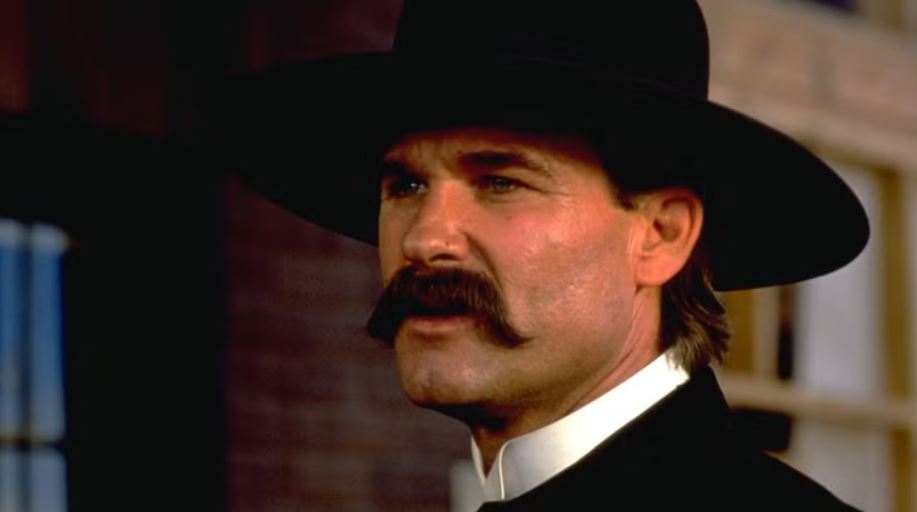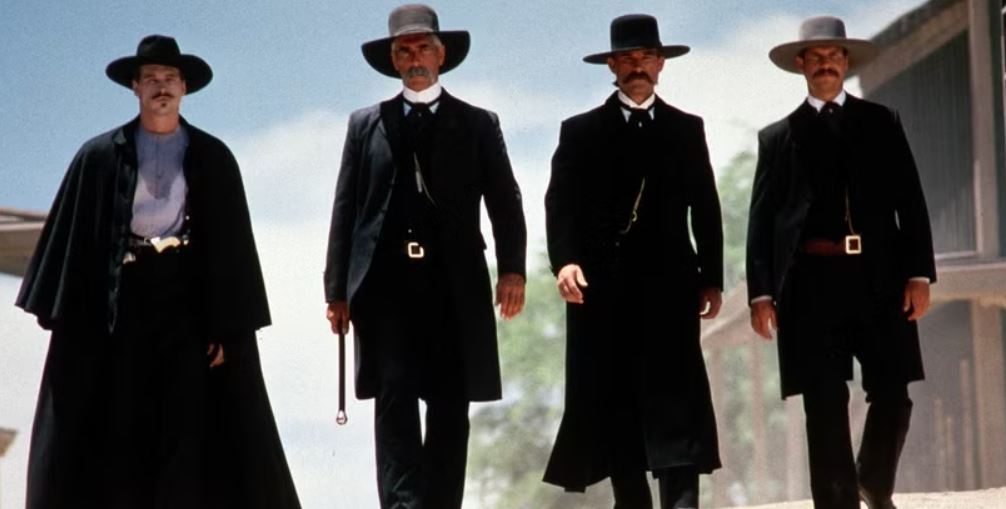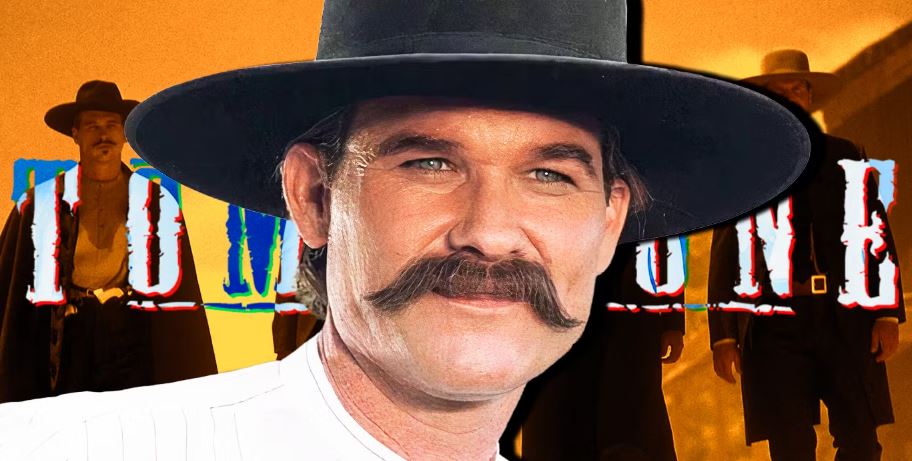Tombstone is no ordinary Western. This early ‘90s ensemble piece has such a wealth of talent strapping on their spurs that audiences are spoiled for choice. Kurt Russell is at the peak of his movie star powers, Michael Biehn barely has Terminator 2 in his rearview mirror, and Val Kilmer can do no wrong. Released in 1993, between Unforgiven and Sam Raimi’s The Quick & The Dead, Tombstone occupies a cinematic sweet spot. In the wake of revisionist Westerns like Clint Eastwood’s classic, and sitting alongside Mario van Pebble’s Posse, Tombstone feels like a return to genre traditions.
George P. Cosmatos was coming off Peter Weller’s Leviathan, and screenwriter Kevin Jarre had the Oscar-winning Glory as his calling card. With a script that clung to conventions and an ensemble that included up-and-coming actors Billy Bob Thornton and Michael Rooker, Tombstone had aces in places. Produced by Andrew G. Vajna, better known as the man behind Paul Verhoeven’s Total Recall and Alan Parker’s Evita, Tombstone also had creative kudos. However, there was no guarantee of success, and 30 years later, film fans have branded Tombstone a classic. The question is, after more than three decades, does it deserve reverence?
Val Kilmer Owns Tombstone
This Is No Revisionist Western
Kurt Russell might have his name on the marquee in Tombstone, but Val Kilmer walks away with every frame. A debonair depiction of Southern civility, cloaked in tuberculosis, who fires from the hip. Kilmer comes at this historical figure with a true artist’s eye for human frailty. Doc Holliday skirts around this gunfight at the OK Corral, overshadowing everyone on screen. Alongside the Western archetypes that others inhabit, his creation feels truly original. In full command of his faculties, playing under the influence with ease, this is a true actor at work. Dennis Quaid played the same part a year later opposite Kevin Costner and Gene Hackman in Wyatt Earp, but Kilmer is the performance people remember. A delicate dandy he may be, but those are the qualities that elevate Kilmer’s performance. Despite his illness, there is a keen intellect at work behind the card-counting mentality. This is why other actors came on set every day to watch him work.
By comparison, Kurt Russell handles Wyatt Earp by employing every trick in his arsenal. Few actors can connect so effortlessly with an audience without trying. With Kevin Costner in the same role a year later, directed by Lawrence Kasdan, Tombstone is the movie that is talked about even now. In a performance that explores ideas of redemption, he stands toe to toe with those who would see him dead and tries to forsake firearms. It is a technique familiar to Westerns going back as far as director John Ford that works by putting anti-heroes in a moral dilemma. Within Russell’s performance, there are elements of masculinity at play that feed back into the cultural expectations of the time. Men were defined through their actions, carried guns with the intention of using them, and killed men for kudos. Only a certain type of actor can pull off those intricacies with conviction, hinting at the conflict beneath without showing weakness.

Wyatt Earp: Are you gonna do something or just stand there and bleed?
Perhaps that is why Kurt Russell has endured and continues to land leading roles at 73. As an actor, he has a timeless quality that has nothing to do with technique but only comes through experience. In a profession of smoke and mirrors, he brings an authenticity to Wyatt Earp that supersedes Western tropes. Aside from Val Kilmer, who runs rings around everyone else on screen, Russell is the only one of the few adding layers to his archetype. Michael Biehn is also able to wrestle more from Johnny Ringo than the script might suggest, adding a hint of intellect beyond his spinning pistols. However, those looking to apportion blame for thin performances elsewhere should look to the script by Kevin Jarre. There are none of the subtleties displayed by David Webb Peoples in Unforgiven that suggest self-awareness. None of the self-reflection that defines that Clint Eastwood classic is in evidence here, and Tombstone is weaker for it. This movie harks back to a time of High Noon and A Few Dollars More, when toxic masculinity in Westerns was acceptable and gender diversity non-existent. However, Tombstone acknowledges that by leaning into homage, predominantly with references to Sergio Leone.
Sergio Leone Has a Huge Influence on Tombstone
Gender Stereotypes Undermine This Movie
Evidence of Sergio Leone is all over Tombstone. A recognized master when it came to defining Westerns on film, his Dollars trilogy is still a high-water mark for many film directors since the first one was released in 1964. George P Cosmatos runs with that trademark style, showing his reverence through camera angles, cut-away shots, and ostentatious use of incidental music. This self-conscious decision to lift from Leone may deliver a trademark Western, but it offers no surprises. In many ways, Tombstone feels like a Western for film fans after a fix. From the opening introduction that sees a bridegroom get shot and his bride-to-be humiliated by Powers Boothe and his men, this feels like familiar territory. Ruthless cowboys who seem incapable of shaving or taking a bath stand in opposition to Wyatt Earp and his men, who stay clean without once going near water. It is a simplistic yet effective way of signaling to audiences who they should root for without putting in the effort of making these characters three-dimensional.
Music is also employed to blatantly manipulate audiences and signpost emotions. Occasionally, the soundtrack can feel jarring and inadvertently works against other elements, diminishing dramatic tension and aging this so-called classic. More than anything, Oscar-nominated composer Bruce Broughton, who would later work on title music for The Orville, embraces Leone’s ethos a little bit too much. That desire to faithfully re-create a specific type of score also makes Tombstone feel like a made-for-television movie at certain points. Granted, those moments are few and far between, but nonetheless, a few seconds of slow motion in an action scene can undo so much good work. That Spaghetti Western style is also reflected in the depiction of women in this world, who are treated as trinkets for their men to admire.
Josephine: Interesting little scene. I wonder who that tall drink of water is.
Dana Delany is much more than a pretty face. Having been in everything from The Union through to Justice League: The Flashpoint Paradox, where she voiced Lois Lane, Tombstone is not her finest hour. In a Western rife with archetypes, she is little more than Kurt Russell’s love interest. She stars as an actor who works for a traveling theater company that happens to catch Wyatt Earp’s eye. Josephine Marcus simply sings and makes eyes at him until he leaves his drug-addled partner, Mattie. Severely under-written and lacking any sense of real character progression, Dana Delany and other women within this ensemble are shortchanged. It is a far cry from Unforgiven, where positive and progressive female role models drive the plot. Without their actions in those opening minutes, William Munny never comes Big Whisky, and crimes go unanswered. Released within a year of each other, these two films feel poles apart, mainly divided by their attitude toward gender stereotypes. A fact that diminishes Tombstone by comparison, making Unforgiven untouchable.

Tombstone Has Some Issues
A-Listers Are Not Enough to Make This a Classic
There is no denying the power of Val Kilmer’s performance. Doc Holliday is more than half the reason why Tombstone has been called a classic, and one article will never change that. What fans need to find is a sense of perspective. Considering the era this film comes from, filmmakers could have done more to read the room. Irrespective of whether George P Cosmatos wanted to acknowledge Sergio Leone, there are no excuses for underwritten roles. As good as Bill Paxton and Sam Elliott might be, their contributions to Tombstone feel thin. Alongside the outdated gender stereotypes that drag it down, there are simply so many actors in Tombstone who have done better work elsewhere. The reputation of a movie can ebb and flow over time, and a rose-tinted perspective has clearly stopped some people from being objective.
Re-evaluation is not always a cause for celebration. Films that have a cult following are not always there to be revered, and sometimes, meeting your heroes can be disappointing. Such is the case with Tombstone, which might have a stacked cast of A-list character actors, but it also comes with drawbacks. Incidental music makes certain moments feel disjointed, outdated attitudes grate, and sometimes production values are compromised. These factors call into question the status of Tombstone as a classic and may cause some to look a bit harder. Putting movies on a pedestal and defending them to death implies a lack of flexibility. Times change, attitudes change, and critical thinking needs to change along with it. In cinematic terms, that is what they call progress.
